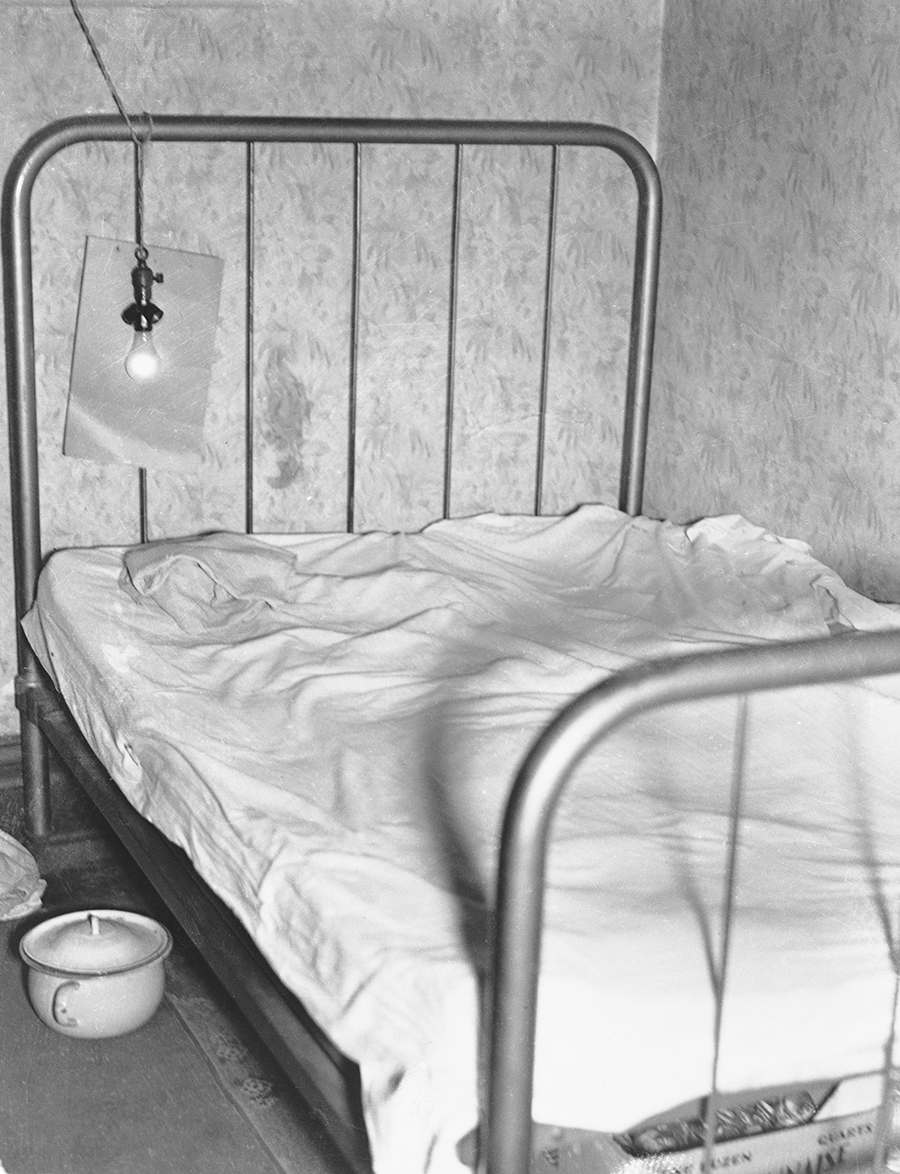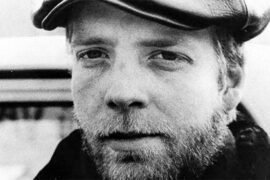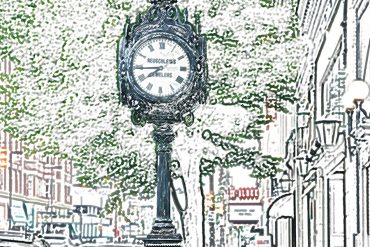Huntington is revered as a quiet and secure community. But lurking in its past is a dark side with true stories of sensational crimes.
By Joseph Platania
HQ 32 | SUMMER 1998
Huntington was not yet 40 years old when it experienced “one of the bloodiest days in the history of the city,” in the words of a contemporary newspaper account.
The year was 1910. William Howard Taft was in the White House, and there was a national census underway that would reveal that Huntington had a population approaching 30,000 residents. The city also had a 30-man police force.
Just before noon on Friday, Oct. 14, 1910, a drifter — possibly a hobo — named Charles Ketchem jumped out of the open door of a boxcar in the yards of the Chesapeake & Ohio Railway shops located along Eighth Avenue in the city’s east end. The new arrival would set into motion a chain of events that day that would result in three deaths and five serious gunshot injuries.
As Ketchem jumped to the ground from the boxcar, he was greeted by George Lenz, head of the C&O detective force. Lenz asked Ketchem where he had obtained a brand new pair of kid leather gloves he was wearing, according to a November 1977 newspaper account. As the two men were walking along the tracks, Ketchem suddenly pulled a large revolver from his pocket and shot Lenz in the back. The gunshot attracted a large number of shop employees and other C&O detectives who rushed to the scene.
The article states: “Ketchem was running down the tracks but stopped 50 yards away, turned and fired again at Lenz, who was leaning on an elbow, shouting for help.” Detectives fired their pistols at the fleeing drifter, only to see him disappear into a hollow southeast of the railroad repair shops.
By 1 p.m., the Huntington Police Department had been notified and a posse of about 50 officers and deputized civilians led by police Lt. Sam Davis started a search for Ketchem. He was last seen headed for Reservoir Hill, a wooded, rocky elevation near the present site of Rotary Park.
Police then contacted Charles Hale, of the city’s west end, who owned a pair of bloodhounds that had previously been used in manhunts. The dogs, along with Hale and another member of the posse, Charles Persinger, “took to the trail.” Both men were unarmed. Other members of the posse carried a variety of firearms.
Suddenly, Hale and Persinger, led by the bloodhounds, stumbled upon Ketchem, who was hiding behind a log. He jumped up and fired his pistol point blank at Persinger before escaping farther up the hillside. Miraculously, the bullet missed Persinger but tore a hole in his shirt.
By 2:30 p.m., nearly 100 armed men were combing the hill, searching for the fugitive while a large crowd of spectators was gathering at the foot of the hill. Ketchem was again located by members of the search party. This time it was by David Thayer, R.H. Moseman and John Forbush. “They found him lying behind a bush eating an apple,” the article reports.
As the three men approached, Ketchem ran and Forbush, armed with a shotgun, aimed straight at the fugitive and pulled the trigger, but the gun failed to discharge. Ketchem continued his escape over the hill and started back down toward the railroad shops when he ran into Hale, George Bias, a 25-year-old C&O brakeman from Hurricane, and others.
At this confrontation “gunfire erupted with bullets flying in every direction,” and Hale fell with a bullet in his side. Bias, who was standing on a rocky ledge, “toppled off with part of his skull and brain shot away,” states the article. Ketchem, who had been wounded, again escaped.
It was nearing 4 p.m. when Ketchem, who had managed to avoid capture for four hours, was sighted a third time. Officer Willis Lowe, C&O conductor J.D. Thomason and George Stuart, a timberman, came upon Ketchem hiding in a thicket. Stuart and Thomason lunged at the man in an attempt to take him alive.
According to the story, in the struggle Stuart was shot in the mouth, the bullet lodging near the temple. It adds that Thomason grasped Ketchem’s pistol just as it went off and took a bullet in the hand.
Then Lowe fired, hitting Ketchem in the head. At the same time, Forbush, who had just reached the thicket, swung his shotgun by the barrel and slammed the wooden stock into the side of Ketchem’s head. Then another shot rang out and Lowe fell, with a stray piece of lead in his neck.
This blood bath was watched by Police Lt. Charles C. Clingenpeel, who was in charge of the posse, from a point higher up the hill. He then raced down the incline to where Lowe, Stuart, Thomason, and Ketchem lay bleeding. Ketchem, mortally wounded, raised his gun in an attempt to fire on the officer, but the shot went wild. Lt. Clingenpeel turned his service revolver on Ketchem and proceeded to empty the gun’s six chambers into his body and the fugitive sank to the ground dead.

When word of Ketchem’s death reached the crowd at the base of the hill, cheering broke out and people swarmed the hillside where the body lay riddled with 15 bullets.
A rope was tied around the desperado’s corpse and it was dragged down the hill to 30th Street. Then it was dragged through the dust to Third Avenue where it was tied to the back of a wagon that proceeded downtown. Ketchem was taken to Johnson’s Undertaking Co. at 918 Fourth Avenue, while the crowd pressed to get a look at the dead man.
The article includes the account of William T. Bess who remembered the scene at the funeral home that day:
“Along with many other school children and others I viewed the body on display at Johnson’s undertaking establishment. He was a big fellow and looked like a perfect physical specimen. They had him covered from the waist down with a piece of heavy canvas … He was badly shot up and the wound on his head inflicted by Forbush was plainly visible.”
The article reprints a photograph of the lifeless body of Ketchem that was printed in The Huntington Advertiser of October 19, 1910.
The battle’s other casualties were C&O brakeman George Bias, who died of his head injury the following day, and Charles Hale, the owner of the bloodhound, who died four days later. C&O detective George Lenz, Officer Willis Lowe, J.D. Thomason, and George Stuart all recovered from their wounds.
• • •
Late in the fall of 1937, one of the most bizarre crimes in Huntington’s history took place — the kidnapping of 79-year-old Dr. James Seder, a capital offense for which three men ultimately paid with their lives. Because of the brutal treatment of the retired Evangelical minister and former missionary to Japan at the hands of his abductors, the case made headlines nationwide.
Dr. Seder was a well-educated clergyman who came to Huntington in 1932. Because of his age and failing eyesight, Seder’s church granted him his retirement in 1935. Despite his disability, he was able to continue his ministry, taking a special interest in the Seventh Avenue Methodist Church and the “Rescue Mission.”
At about 8 p.m., Nov. 1, 1937, Dr. Seder was seen entering an automobile that had stopped in front of his home at 21st Street and 8th Avenue. A tenant of the second floor apartment in Seder’s home “became alarmed the next day over the absence of the minister and notified police,” states an article.
Police forced their way into the Seder home and found all of the bed clothing gone from Dr. Seder’s bed; the rear door was unlocked and the white canes that the minister habitually carried with him were where he always kept them.
Dr. Seder’s wife was out of town. Police also said there were rumors that the retired clergyman kept large amounts of money in his house.
After several days had passed, “police became more convinced that Dr. Seder’s disappearance was not voluntary,” according to the article. Posters with Seder’s photograph were sent to cities and towns within a 500-mile radius.
An article states that on November 6,600 Boy Scouts and schoolboy patrols searched more than half of Huntington for the elderly minister. However, the search proved fruitless. After more than a week had elapsed and with every lead checked, police detectives were baffled by the mysterious disappearance. Then, ten days following the clergyman’s vanishing, there was a break in the case.
During the afternoon of Nov. 11, 1937, Albert and Edgar Ronk, farmers on Gragston Creek, in an isolated section of nearby Wayne County, were walking up the creek hollow. As they passed a small, worn-out mine that opened into a ravine, “they heard weak cries for help coming from inside,” states an article. Following the sounds, the two farmers “found huddled at the rocky entrance an old man — eyes blackened, head lacerated and suffering from exposure and nervous shock. It was Dr. Seder.”
With labored breathing, the elderly man told the story of his abduction for ransom to his rescuers.
One of the Ronk brothers went into the town of Wayne, the county seat, to get a deputy sheriff to accompany him back to the site where they had found Seder. Unable to find a deputy, Ronk encountered Menis E. Ketchum, a deputy U.S. Marshal and former sheriff of Wayne County. He told Ketchum about his discovery and the marshal immediately organized a rescue party comprised of himself, Ronk, Dr. Glenn Johnson and two other men and they proceeded to the site by car.
The aged man was taken to Dr. Johnson’s office where he was given some nourishment and then rushed to a Huntington hospital.
Seder told law enforcement officials that he was first held in a shack on Gragston Creek and then put into the abandoned mine. Bed clothing from Dr. Seder’s bed was found at the mine as well as a blood-soaked pillow and shirt. Because it was a kidnapping, “ten FBI agents assumed charge of the case at once,” states an article. The day after Seder’s rescue, Arnett Allen Booth, 46, a truck driver, John Travis and Orville Adkins, both 25, of Huntington, all ex-convicts, confessed to the kidnapping. Booth and Travis had been picked up in Huntington and questioned while Adkins was arrested in eastern Kentucky. The link between Dr. Seder and his kidnappers was established when it was reported that Booth lived in an apartment at 803 21st Street that was owned by the retired minister.
After his rescue and having been brought to the doctor’s office, Seder said he had been unconscious since the preceding Saturday.
In an article, FBI Agent Vetterli said that the kidnappers had demanded $50,000 ransom for the return of the minister alive in a note sent to Seder’s son. However, the son had not received the ransom demand because he had come to Huntington to help in locating his father.
On November 15, Dr. Seder died of pneumonia. An article states that during his captivity, Seder had been struck by stones. In his confession, Booth declared that after leaving Seder unconscious, he walked up the steep entry way leading from the mine carrying the blood-splattered stones. He then turned and hurled them at the aged man.
The article reports that “Booth never intended to return Dr. Seder to his family even if ransom demands were complied with.”
As the facts of the case became known, it was reported that the kidnapping was part of a larger plot, according to the head of the FBI.
An article states that FBI director “J. Edgar Hoover announced from his Washington office that the three suspects had admitted to federal agents in Huntington that the abduction of Dr. Seder was the first in a series of kidnappings plotted by a West Virginia gang.” Hoover added that “the proposed victims included the son of a prominent contractor and the president of a local finance company.” The three kidnappers were later found guilty of murder in the first degree. Their verdicts were without a recommendation for mercy, making the death penalty mandatory.
An article states that after an unsuccessful appeal, “on the night of March 21, 1938, the three kidnappers walked into the death house at the West Virginia Penitentiary,” where they were hanged by the neck. The executions brought closure to what has been called “the biggest crime case in the history of Huntington.”
• • •
Many people who come to downtown Huntington pass by the intersection of Fourth Avenue and Ninth Street. This intersection is dominated by the 15-story West Virginia Building, a skyscraper that was built in the mid-1920s and was, for many years, the tallest building in the state. The corner in front of the building once was dubbed “the busiest corner in town.” Near this spot, almost a half-century ago, one of the most horrific crimes in Huntington’s history took place.
On Friday, September 30, 1949, with lunch-hour crowds on the corner of Fourth Avenue and Ninth Street, two bodies, one after another, came hurtling out of a window near the top of the West Virginia Building, plunging 14 stories to their deaths on the sidewalk along Fourth Avenue. The dead were Claude S. Hatton, age 44 and a Huntington mail carrier, and his four-year-old son, David. Miraculously, considering the throng of people then on the sidewalk, no one else was injured.
According to the newspaper account, police said witnesses told them that Hatton apparently tossed the child out of the window and then jumped himself.
The boy’s mother, Mrs. Frances M. Hatton, was a teacher at the Cook School, located in Johnson’s Hollow, south of West 14th Street. It adds that the family lived at 2204 Eighth Avenue in Huntington.
Hatton’s doctor told the newspaper that he had prescribed medicine for him several days earlier, but Hatton was only suffering from indigestion.
Police established the time of death at 12:55 p.m. Two women from Barboursville were walking east on Fourth Avenue when the boy’s body fell in front of them. As one woman looked up, Hatton’s body grazed her and landed at her feet. A third woman fainted and another “began screaming hysterically.”
A witness told police that she was in a taxi on Ninth Street when she saw Hatton throw the boy out of the window and then jump himself. A report adds that the crowd was especially large that day because a street radio broadcast with nearly 50 people around the microphone had ended just minutes before the crime.
Earlier, Hatton, holding the hand of the small boy, had been seen in the lobby of the West Virginia Building before entering the elevator. The article reports that elevator operator Neva Steele said she took Hatton and his son to the 15th floor and didn’t see them again. Steele recalled that she noticed the little boy because of his blond, curly hair. It adds that when they entered the elevator, she said to the man, “You’ve got a cute boy there.” She said the man replied, “Yes, he can be cute when he wants to be.”
A carpenter who was remodeling the 14th floor told police that he saw Hatton and his son on that floor about 12:45 p.m.
During the investigation, the building manager, along with the police, discovered a wallet, hat and keys in the room from which the two had plunged to their deaths. Also, the dust on the window sill of the room had been disturbed, indicating the place from which the man and his son fell. Police theorized that Hatton went to the 15th floor with the intention of leaping from there, but finding all unoccupied rooms locked and no open windows, he descended to the 14th floor.
However, this is not the only tall downtown building Hatton had tried that day. An article states that an elevator operator in the C&O Building (now the Coal Exchange Building) at Fourth Avenue and 11th Street reported that around noon a man and a small boy fitting the description of Hatton and his son entered the building’s lobby. The story adds that the operator quoted the man as saying, “Didn’t I see somewhere in the newspaper where a person could come here and see the city from the roof of the building?” The operator replied “Yes,” but the building superintendent would have to accompany him.
“The man walked briskly out,” says the story. The operator recalled that, “He walked out so fast that the boy, walking behind him, was almost caught in the revolving door.” She identified the boy as having blond, curly hair.
The article reports that a police sergeant told Mrs. Hatton at her school about the death of her husband, but omitted the details and said nothing about her son. She asked the sergeant if her husband “committed suicide,” to which he replied, “Yes.”
Police could offer no motive for the murder-suicide as Hatton’s health wasn’t an issue.
The Huntington postmaster recalled Hatton as being “jovial” and said he had last worked on Tuesday. But on Wednesday, he had called in sick.
Hatton had been employed with the United States Postal Service for more than 25 years and had been a letter carrier for 19 years with a route between Fourth and Eighth Streets and from Fourth Avenue to the Ohio River.





